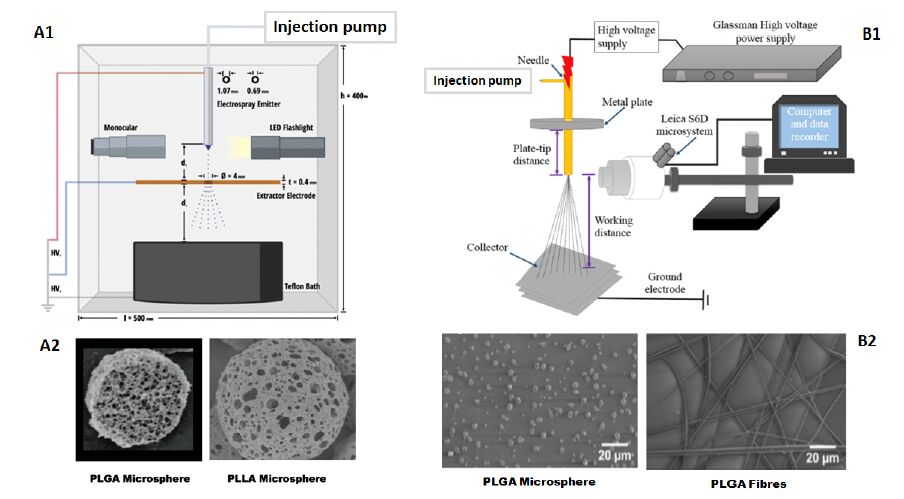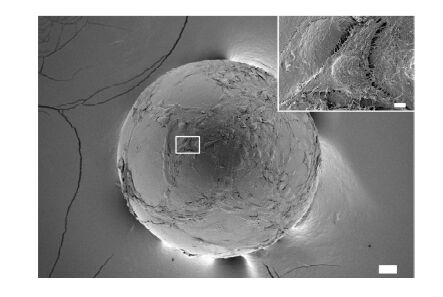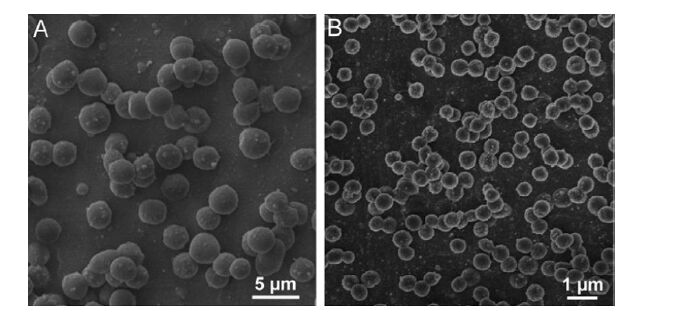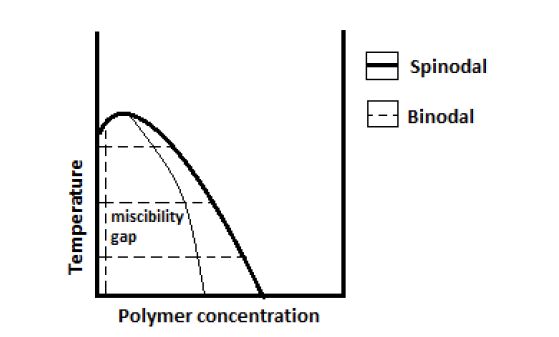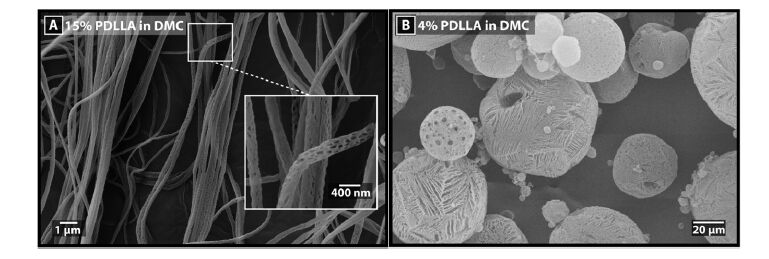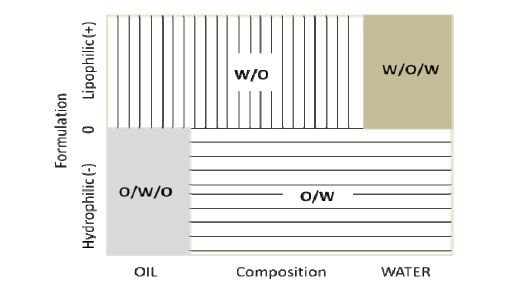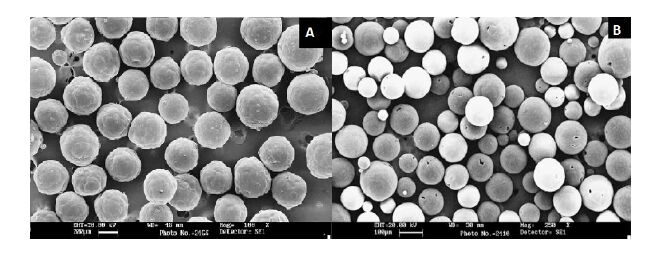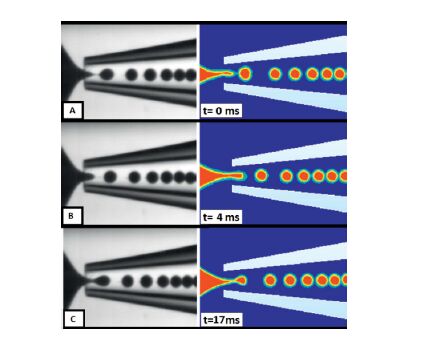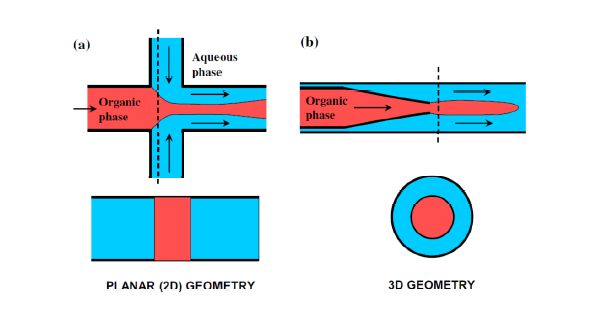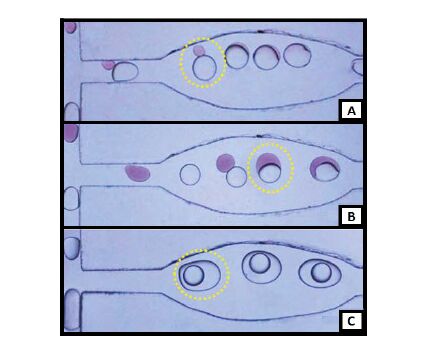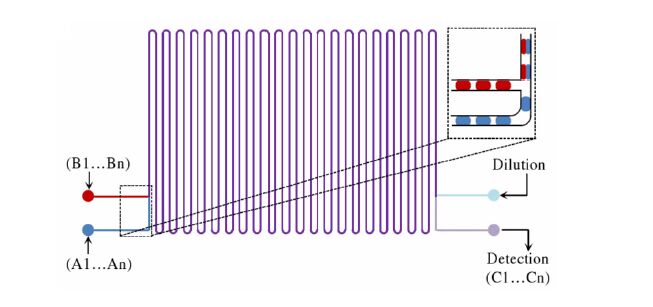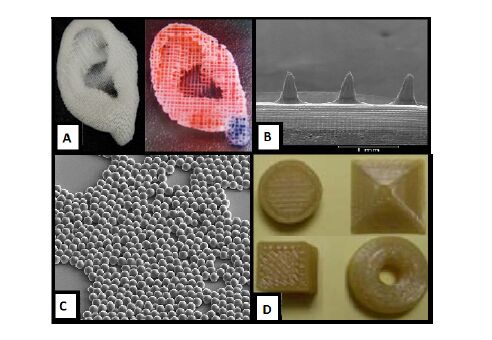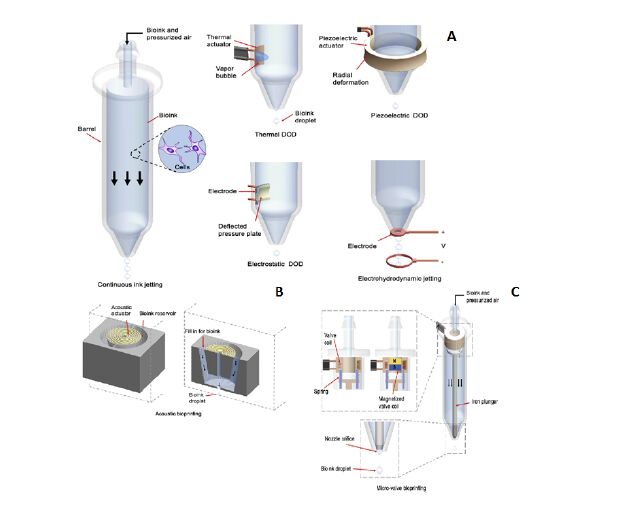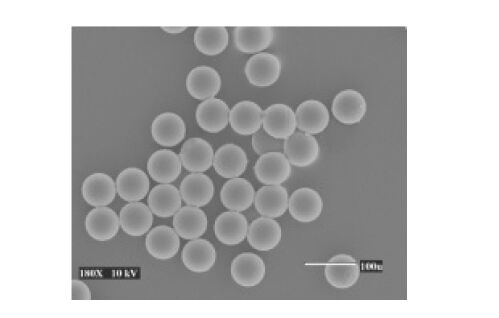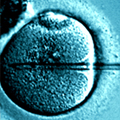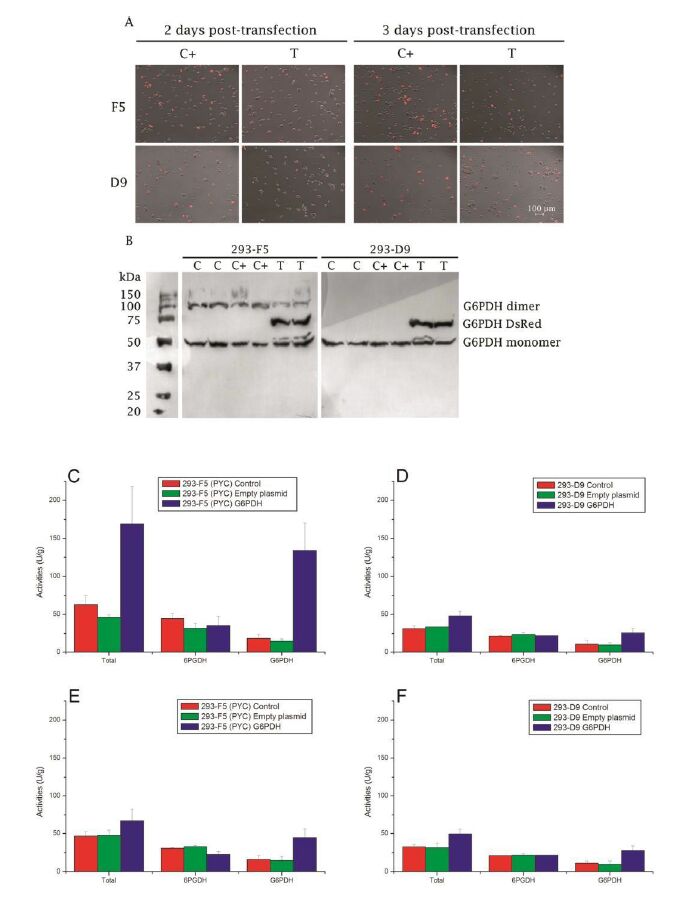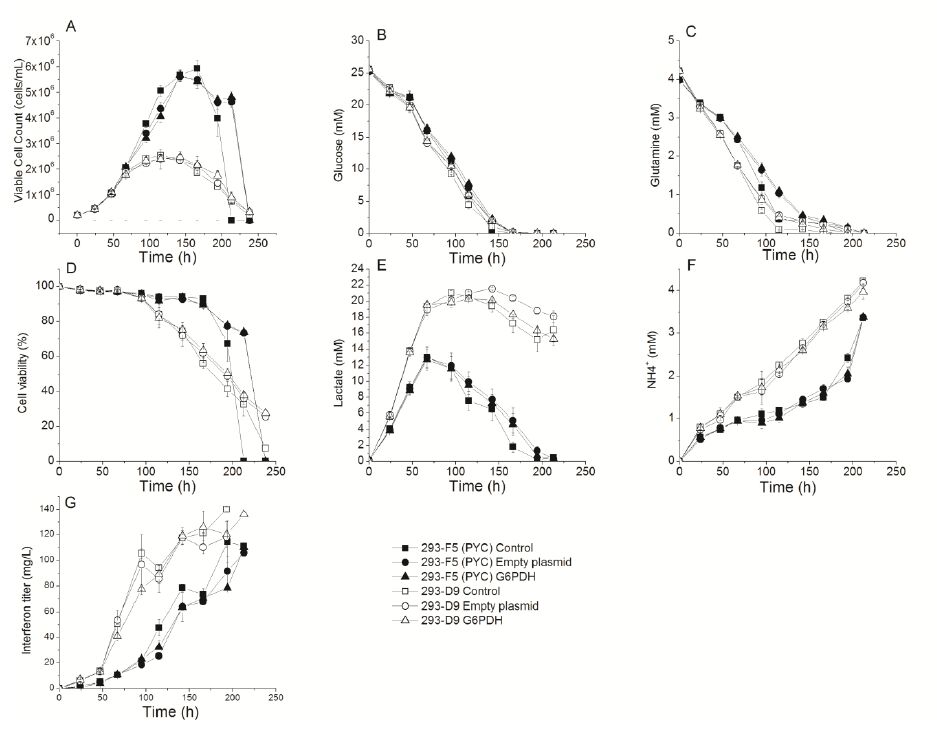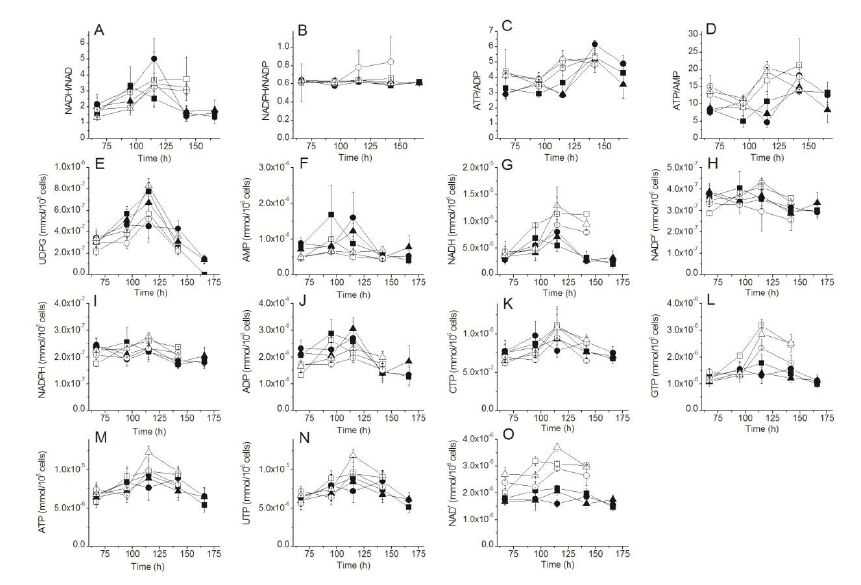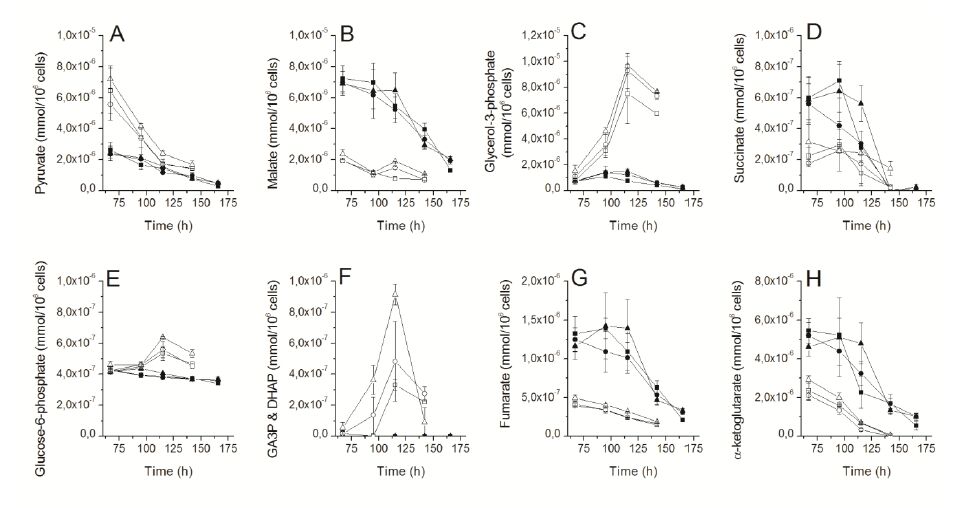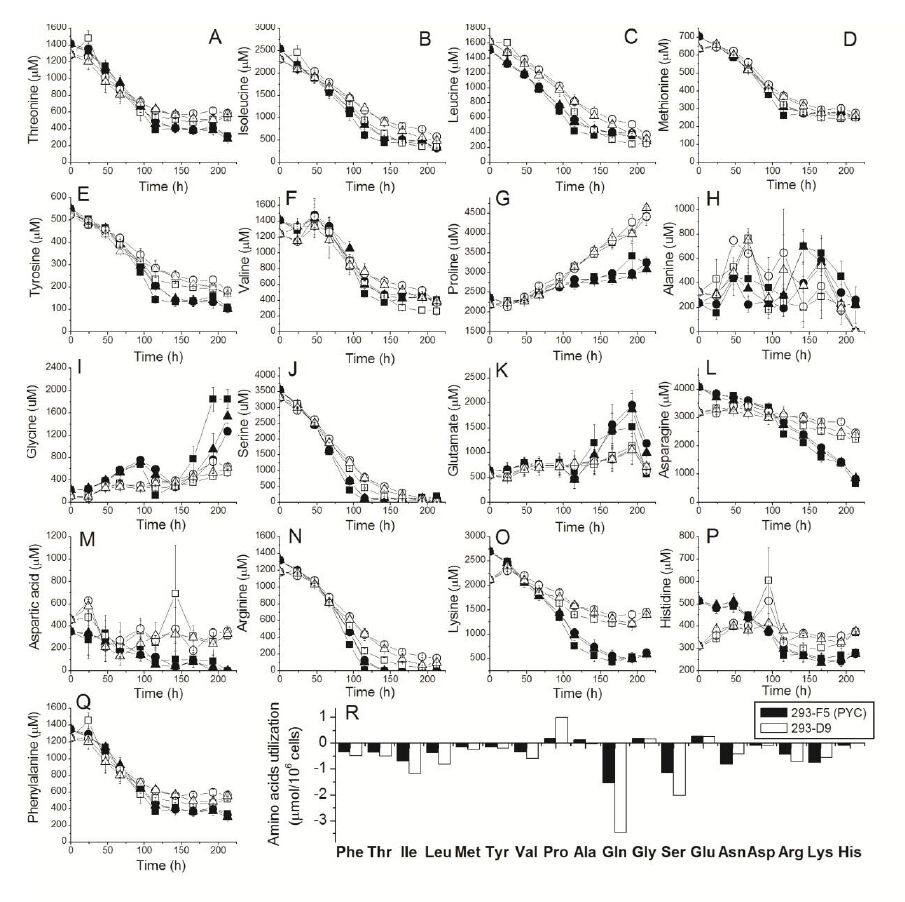1. Introduction
Polymer-based micro and nanoparticles have received considerable attention over recent years for biomedical applications, especially when considering degradable materials for drug delivery. Varying manufacturing processes have been utilised, which have made it possible to control the features of these particles including size, porosity, roughness and morphology [1,2]. The size of the particles also determines their applicability and has enabled their use in controlled drug release applications for cancer, diabetes, malaria and many other disease indications [3]. The particles most commonly used are either micro and/or nano sized spheres and with or without porous features [4].
These particles have been developed to carry drugs to target sites whilst protecting them from physiological environments, controlling their release rates (thereby improving the efficacy of conventional dosage forms) and reducing toxicity and side effects [5,6]. This method of drug delivery can help to improve patient compliance and potentially control drug clearance by the kidneys [7]. The characteristics of particles developed for biomedical applications must be carefully selected to determine their stability and efficiency. As well as considering the drug delivery aspect, it is also necessary to consider the residence time of the particles in the body, which tissues they will reside in, how they will degrade (i.e. via hydrolysis or enzymatic routes) and how they will be excreted [1].
Depending on the size of the particles, they can be used to specifically target channels on cell site or be engulfed to deliver drugs from within the cell [8,9]. They can also be delivered through the bloodstream, between vessels and capillaries or even to the respiratory tract as an aerosol formulation [8,9]. Nano scale materials in particular have been studied extensively as particulate carriers for several pharmaceutical and medical applications [7]. Table 1 provides an overview of the particles developed, their sizes and relevant target indications.
Table 1. Applications for micro/nano particles in delivery of therapeutics.
| Tissue |
Delivery Target |
Particle Size |
Reference
|
| Eye |
Ocular |
1 um |
[10]
|
|
Respiratory tract |
< 3 um |
|
|
Capillaries |
2 and 13 um |
|
| Lung |
Tracheo-bronquio |
> 10 um |
[11,12,13]
|
|
Alveolar region |
< 100 nm and 1 to 5 um |
|
|
Bronquioles |
500 nm to 1 um |
|
|
Alveoli |
< 250 nm |
|
|
Endothelium fenestrate |
< 60 to 80 nm |
|
| Kidney |
Glomerulus |
< 5 to 6 nm |
[13]
|
|
Filtration diagram |
< 4 to 6 nm |
|
|
Perisinusoidal space |
< 50 nm |
|
| Liver |
Billiary excretion |
< 6 nm |
[13]
|
|
Sinusoidal sieve |
< 200 nm |
|
| Blood |
Blood stream |
< 100 nm |
[13]
|
|
Tumour site |
< 50 to 100 nm |
[14]
|
The sub-micron size of nanoparticles offers a number of distinct advantages over microparticles. The main advantage is the general relatively higher intracellular uptake of nanoparticles compared to microparticles due to their size, which can also increase their absorption rate, improve drug bioavailability, protect them from degradation and improve patient-compliance [1,2,15].
Nanoparticles of both natural and synthetic biodegradable polymers, lipids and polysaccharides have been extensively studied [16]. Some of these have been developed as injectable drugs which require a size range between 5 nm to 250 nm. The size is one of the most important physical parameters as this can alter the biological function of injected particles and their circulation between veins and capillaries. In addition, these particles have the ability to flow in the blood stream and target pathological tissues such as tumours [17]. According to Rezman et al. natural biomaterials exhibit favourable biodegradability and biocompatibility with lower toxicity issues [18]. Some natural polymers can control the duration of active agent activity, improving their efficiency and reducing side effects through modification of the pharmacokinetic profiles, which improve drug viability between tissue and cell channels choosing different routes to deliver chemical signals to a specific site [19]. Natural polymers as well as synthetic polymers can control drug release and show biodegradability features. Lim et al. developed microspheres loaded with Insulin from natural polymers (i.e. Chitosan and Alginate) which showed better drug release profiles in comparison to poly (lactide-co-glycolide) (PLGA), poly (lactide) (PLA) and olycaprolactone PCL [20].
The most widely used synthetic polymers are PLA and PLGA, which can generate acid environments during their degradation processes [10,18,21,22]. PCL is another synthetic polymer, which has been extensively investigated to produce micro and nano spheres for drug delivery applications. PCL has shown delayed degradation characteristics and takes several years to be completely removed from the body [18,23]. The mechanism proposed suggested hydrolytic ester cleavage during degradation through the diffusion of oligomeric species, which do not generate an acidic environment during drug release [18]. In addition, as a bioresorbable polymer PCL has also been explored for potential applications in bone and cartilage repair due to its elastic modulus and compressive strength which are similar to cancellous bone [18,24]. PCL is also more stable in ambient conditions as it is demonstrated stable pH for 6 months in a protein encapsulation system indicating that protein antigenicity was not affected. Thus conferring drug protection in acidic environments such as the stomach allowing drugs to pass intact into the intestine improving the transport of drugs across the intestinal epithelium [22,25].
The above mentioned polymers lead to production of non-toxic degradation products that can be metabolised and excreted via normal physiological pathways [26]. Polyethylene glycol (PEG) has also been heavily investigated for drug delivery applications and has been shown to stabilise micro particles as spheres in both gastric and intestinal fluids due to inhibition of plasma protein adsorption and reduced interaction with macrophages creating a layer on the particle surface (fixed aqueous layer) that minimises unwanted interactions due to its repelling characteristics [27,28,29].
Micro- and nanoparticles have been produced under carefully controlled conditions to achieve varying levels of porosity, pore interconnectivity, size and smoothness. They can also exhibit reproducible and predictable physical properties and degradation rates [18]. This short review will focus specifically on the current state-of-the-art manufacturing processes and parameters to produce polymer micro and nanoparticles with various characteristics such as size, porosities and morphologies for several applications.
2. Micro and Nanoparticles Manufacturing Process
2.1. Spray-drying
According to Fleming et al. the spray drying process was developed by Robert Stauf for the drying of blood, milk and other highly complex organic liquids in 1901 [30]. In this process particles are formed by spraying droplets of fluid into a chamber and drying them with hot air, which causes the rapid evaporation of solvent from the droplets. The feedstock used can be in the form of a solution, suspension, emulsion or paste. The resulting particles can be powders, granules or agglomerates and can be dense, porous or hollow depending on the process parameters utilised. Moreover, mixtures of drug and excipient solutions utilised are feed into the chamber and produce particles/powder in the form of microparticles. The size of these droplets/microparticles can be altered by changing the atomisation energy, with smaller droplets formed by using higher atomisation energies [31,32,33,34].
The properties of the dried product formed depend on the physical and chemical properties of the feed and the dryer design, the operation of which is normally automatic with tightly looped control. There are a number of advantages in using this technique to produce powders: i) it is a rapid, continuous, reproducible, single-step technique and shows a superior quality to dry products which are heat-sensitive avoiding the degradation from their chemical components; ii) powders can be produced in a specific particle size, morphology and moisture content, irrespective of the dryer capacity; iii) some parameters can be adjusted very easily, such as solvent composition, solute concentration, temperature and nozzle size; iv) particles can be purely the drug, without a need for a carrier; v) powders obtained from this technique have better flow properties than other methods because of its spherical nature which is well defined; and vi) this technique can improve conservation of the products in dried solid forms allowing products to be more stable according with the type of formulation without any degradation [2,34,35,36,37,38].
Since spray drying is usually the end-point of an industrial process, it can also influence the quality of the final product. Moreover, the development of an active compound to encapsulation system producing micro and nano particles for pharmaceuticals formulations, cosmetics and functional food preparation, has attracted more attention over recent years [2].
Normally the particles generated in spray dry systems are small, typically < 10 µm. This size is essential for pharmaceutical formulations including powders for asthma inhalers, inhaler to control diabetes or other applications such as a multi-functional interactive excipient for tablet formulation. Furthermore, this technique showed an improvement to insert many types of drugs without interaction with each other [35,39,40,41].
More recent developments have enabled the production of even smaller particles in the range of 100 nm to 5 µm by utilising vibrating mesh sprays with an orifice smaller than conventional spray dryers (500 to 700 µm) [11]. This process prevents the use of highly viscous polymer solutions but can be considered for use with expensive materials such as monoclonal antibodies. This technique also enables encapsulation of active agents of diverse physicochemical properties within different polymer matrices (synthetic, semi-synthetic, or natural origin) under very mild and non-detrimental conditions and with high encapsulation efficiency. In addition, the technology is less dependent of the drug solubility and polymers than other methods [42].
Another technique, which was introduced as an innovative process to produce submicron drug particles, is spray-drying technology with a vibrational atomization system [43]. This equipment generates a fine aerosol of droplets with controlled size, which can dry droplets fast and cause an electrostatic deposition of particles on the surface. The advantages of this equipment are: i) drying and collection of particles smaller than 2 µm, and ii) production of polymeric particles with a range between 300 nm to 5 µm. Even as a spray dryer this technique has similar advantages in comparison with previous conventional Spray Dry technology [44,45].
2.2. Electrospray/Electrospinning
Electrospinning process es have been reported since 1971 when fibres were produced from polyacrylonitrile in a dimethyl formamide solution with diameters ranging from 0.05 to 1.1 µm. Interest in this technique has since increased exponentially due to its adaptability to a wide range of polymeric materials and applications [46].
Electrospraying uses constant liquid flow through a needle and constant pressure with high electrical potential after dispersion the solution as fine droplets before solvent evaporation [47], whilst electrohydrodynamic spraying generates an electrical potential inside the needle and nozzle controlling the size distribution of droplets, which become spherical particles [48] as shown in Figure 1. Both processes are controlled by the liquid viscosity, needle diameter, pressure and distance between the needle tip and collector plate [42,49]. By careful selection of these parameters, droplets can be deposited individually or are deposited so as to agglomerate into a film. Droplet sizes can range from micrometres to nanometres and can generate films from 40 nm to 2 µm thick, which can be controlled using this process.
The principles of electrospraying are similar to those of electrospinning, except that fibres are formed in the latter case. Using the same polymer and equipment, either particles or fibres can be produced depending on the solution viscosity. This technique shows advantages such as produce particles (microspheres and fibres) without surfactant, high molecular weight polymers and less shear stress [50]. Using a high concentration polymer solution will usually produce fibres, whilst a low concentration will form particles [51,52]. On the other hand, there are some disadvantages which limit this manufacturing process (as represented in Table 2).
Table 2. Advantages and disadvantages of electrospray and electrospinning process to produce particles and fibres.
| Advantages |
Disadvantages |
References
|
One step
High Molecular weight polymers
Nanoparticles are obtained
Use fewer solvents
Does not use surfactant
Monodisperse particles with high efficiency
Less shear stress than the emulsion technique
Narrow size distribution can be produced
Control of particles size
Requires no heat
Manufacture of porous fibres and spheres |
Small amount of particle is obtained
Use cross-linking agent
Does not consider the relative humidity of the spinning environment affecting particle morphology
Control humidity level |
[54]
[51]
[62]
[63] |
In addition, particle morphology has been reported to be dependent on chain entanglements, entanglement volume fraction (Øent), overlap volume fraction (Øch.ov), Rayleigh limit (ØRay) and Coulomb fission [53]. Chain entanglements is a direct consequence of chain overlap and produce fiber formation in electrospinning while Rayleigh represent the rupture of the droplets and the last stage for evaporation process. Furthermore, Coulomb fission preserve the monodispersity and sphericity of the droplets [53,54].This approach showed that these parameters, Øch.ov < ØRay < Øent were important in preserving droplet integrity using the electrospray process [53].
Particles with 80 nm of size have been produced using low flow rate, increasing the electrical conductivity, smaller jets which increase volatilization of solvent and specific work distance from the collector [54]. In addition, this method has been used to produce porous microspheres as shown in Figure 1 [47,55,56].
The electrical potential (Ø) produced during the manufacture process could affect the size and form of droplets and a potential of sufficient electric charge is required to overcome the surface tension of the polymer solution to produce micro- and nanoparticles. Higher voltage (9 kV) has produced micrometric particles (400 µm) and voltage at 15 kV reportedly provided greater stability of the jet cone and the diameter of the particles formed were between 3.4 µm and 10 µm. The collector distance allowed more volatilization of the solvent and generated smaller particles [54] and drug delivery applications as particles, which were generated by electrospray [51]. Shear viscosity and formulation concentration influenced the particle morphology, which for spherical particles was important to consider the high shear viscosity and high concentration of solution as shown in Figure 2. These particles showed cell adhesion from day 1. After 4 days of incubation the particle surfaces were covered with dense and compact cell layers [51] exhibiting fibrillary networks. In addition, these particles showed were stated to have potential cell therapy applications for several cell types, such as osteoblasts [57,58], chondrocytes [59] and stem cells [60]. Almeria B et al. showed that PLGA particle morphology influenced the affinities of anchoring on targeted cells and particles with large surface-to-volume ratio were preferred for targeting [53].
Lee et al. demonstrated the fabrication of PLGA-coated multiple drug composite particles for tissue engineering and regenerative medicine applications. These particles were manufactured in a tri-layered structure with sizes ranging between 2.79 and 3.32 µm via the electrospray system [61]. It was reported that this technique did not affect the cells and proteins were still activating after spraying. Particles were also developed to encapsulate multiple compounds within the unique shell layer structure as shown in Figure 3. Furthermore, the drug release profiles of these tri-layered composite particles could be controlled by tuning the layer thickness and material composition of the layers [61].
According to Gao et al. , the electrospray process was able to form polymeric droplets via direct spray into a cooling system, which was caused by rapid evaporation of solvent and water [64]. This system was water-condensed with phase separation (solvent evaporation) promoting porosity in the microspheres produced. In addition, polymer diffusion during this process was important to influence morphology of the final product porosity on and within the microspheres. These microspheres ranging between 1 µm to 1000 µm, were also generated from a non-solvent bath such as a cryogenic liquid to also produce pores in the particles [47].
Fibres were created by electrospinning into the same non-solvent system (cryogenic liquid), resulting in thermally induced phase separation (TIPS) within the fibres. Porous fibres were also produced via electrospinning using highly volatile solvents [65], as well as polymer blends followed by selective dissolution [66].
2.3. Solution blow spinning/Atomization
This technique requires a similar set of apparatus to that used for the electrospray process, which includes using concentrated polymer solution in a volatile solvent and a high-pressure gas source to control the rate of droplet formation from the polymeric solution. The porous structures and spherical morphology formed have been attributed to several factors such as fast absorption of oxygen in air by the solvent, decreasing surface temperature due to fast solvent evaporation (which can affect moisture condensation on the surface), working distance, polymer molecular weight to minimise the surface area in contact with the surrounding atmosphere and phase separation [62,67]. The pores and their sizes developed, therefore also depend on multiple factors such as surface tension, solution viscosity, polymer molecular weight, glass transition, solvent diffusion and polymer-solvent interaction.
According to Medeiros et al. , when the relative humidity was higher than 25% in the Solution Blow Spinning process, pores were created due to solvent volatilization and phase separation. The tendency for pores to coalesce was reduced due to the rapid increase in polymer viscosity, which resulted in well-defined porous structures. However, not all hydrophilic polymers form porous structures in high humidity environments. For example, hydrophobic polymers did not necessarily exhibit pore formation as it was necessary to consider additional factors such as type of porogen used, solvent evaporation rates, internal pressure and relation between diameter contraction of particle and surface tension [49].
The phase separation mechanism was another factor, which needs to be considered and this type of mechanism, shows the influence in particles by nucleation and growth. This property closed pores were attributed to the combination of liquid-liquid mixtures with crystallisation of the polymer, vitrification and crystallisation of the solvent, which are important for generation of pores structures. In addition, the size and interconnectivity of the final membranes could be controlled by the polymer concentration and the cooling method avoiding possible closure of pores [68].
Spinodal and Binodal behaviour represent a method to analyse the interaction among colloidal particles and their response in different applications [69]. Furthermore, spinodal decomposition is a region where the interconnected porous structure was generally attributed to phase separation by the spinodal decomposition mechanism. This mechanism takes place in the unstable region of the phase diagram by rapid initial growth of high concentration fluctuations, referred to as the late stage of transformation as shown in Figure 4. Furthermore, the components can form a rapidly solidified skin with micro and/ or nanopores where the aqueous environment helps the fast formation of skin with well-defined pores [58,62,68,69,70].
Solution Blow Spinning (SBS) can also produce microspheres with pores and with non-porous structure. Rajendran et al. [71] published on the fabrication of sol-gel fibres via the SBS process and then Behrens et al. [67] used a commercial airbrush system to produce nanofibers via this method. This technique for fibre production included a wet spinning tool, where the solvent was evaporated and fibres were subsequently drawn. A chemical bath was also included in this system to improve polymeric precipitation by dilution. In contrast, other systems such as dry systems do not require liquids, where solidification of solvents occurred via evaporation [49,67,71].
Fibre production via the dry system technique is well established, and continues to advance with increasing development of new materials. However, more recently Medeiros et al. utilised the SBS process to also produce porous spheres as shown in Figure 5. This study showed the fabrication of particle diameters ranging from approximately 500 nm to 75 µm, which were created via phase separation of the polymeric concentration in a liquid nitrogen bath.
2.4. Emulsion cross-linking
This method uses a disperse and continuous phase (emulsion) to produce micro and nano spheres. This process can include different types of formulations such as i) single emulsion as water-in-oil (W/O) and oil-in-water (O/W); and ii) double emulsion as water-oil-water (W/O/W) and oil-water-water (O/W/W). Varying the combinations of these formulations, such as amount of oil and water in a system, can change the hydrophilic or lipophilic properties as showed in Figure 6. These properties can have detrimental effects on the type of spheres produced such as size and shape [72]. Formulations which show excess of oil are considered macro-emulsions as (O/W) and it is represented by the Winsor I region, which shows low hydrophile-lipophile balance (HLB). On the other hand formulations with excess water are represented by the in Winsor Ⅱ region such as (W/O), which shows high HLB and presence of micelles [73]. Winsor ⅡI regions represent a composition with oil, water and a "middle" bi-continuous micro-emulsion phase which all coexist in three-phase equilibrium. Figure 5 represents the molecular behaviour near the interfacial limit between the oil (O) and water (W) phases [72,74].
The oil droplets dispersed in the water phase consist of the O/W formulation and emulsifiers are usually added in this type of formulation as the water phase is dispersed in an oil continuous phase (W/O) [76]. It is also possible to produce different types of multiple systems where the dispersed phase contains even smaller dispersed droplets. In addition, surfactants can form a protective membrane on the surface of the droplet, which reduces the risk of droplet coalescence [77]. The physicochemical properties, such as rheology, stability and optical properties of these formulations are highly dependent on the characteristics of their droplets. In turn these characteristics are determined by the homogenization conditions (e.g. intensity and duration of energy input) and system composition (for example the type and concentration of emulsifier used or the viscosity ratio between the dispersed and continuous phase) [76,77].
Traditionally small-molecular weight surfactants have been used as stabilizing agents for both the inner and the outer interfaces for the double emulsion systems. In such systems, thermodynamically or physicochemical instability errors are corrected by the addition of a third component, which emulsifies the system and controls the release for drugs inserted in micelles [78]. In addition, stable emulsions which present small droplet sizes cause a reduction of the gravity force and Brownian motion preventing the flocculation of the droplets [76,78].
The size of the particles produced can be controlled by the velocity of stirring, type of stirrer used and the final water phase and the proportions between them [78]. It should be noted that in this process it is necessary to use immiscible liquid phases to produce particles which could be micro or nano in size. According to Luciani A et al. single and double emulsion systems showed production of microspheres with varying diameter ranges from 300-500 µm and 100-500 µm, respectively (see Figure 7) [25].
According to Rao et al. [79] nanoprecipitation by the double emulsion system depends on some basic components such as: type of polymer (synthetic, semi-synthetic or natural), the organic phase (polymer solvent) and continuous phase (non-solvent phase). Organic solvents, which can easily mix with water and can be removed by evaporation are a good choice for polymers. Non-solvents such as surfactants can influence the polymeric sphere size and preservation of nanoparticle suspension from agglomeration, over long storage periods. The size of the spheres produced ranged from between 63 and 560 nm. [79].
Kumbar et al. [80] used the emulsion cross-linking method to prepare chitosan microspheres to encapsulate diclofenac sodium using the cross-linking agents glutaraldehyde and sulphuric acid and also explored the use of heat treatment. This technique produced particles ranging between 2 to 10 µm. Particle size was less affected by the inlet air temperatures (between 140 and 180 °C) [80,81].
2.5. Precipitation polymerization
Precipitation polymerisation has been used as an encapsulation method [82], is the unique to produce microspheres with uniform shape and size [83] and has received particular attention because of its ease of operation and the lack of requirement for any surfactant or stabiliser. This chemical reaction starts from a homogeneous mixture of monomer, initiator and optional solvent. Varying precipitation polymerisation approaches based on the conventional controlled/"living" radical polymerisation (CRP) mechanisms have been developed for the preparation of uniform crosslinked spherical polymer particles, such as traditional thermos-induced precipitation polymerisation obtaining uniform functional polymer microspheres and allow efficient functionalization [84], traditional photo induced precipitation polymerisation, which induce macromolecular growth influenced by temperature range [85] and distillation precipitation polymerisation producing narrow disperse polymer microspheres (142 to 283 µm) [83,84].
The polymerisation process provides stability for the emulsion system hence there is no need for a surfactant and can provide particles ranging from between 50 nm to 500 nm dispersed in a continuous phase [86] and modified the diameter from polymeric particles increasing this range [87]. On the other hand, polymerisation reduces the size of the droplets and increase stability, which avoid degradation and coagulation when an surfactant/fatty alcohol increase the concentration into the system [88]. The chemicals involved in this type of system require free-radical polymerisations of the reactive group such as acrylate and methacrylate which are polymerised via redox or thermal initiation [89]. The rate of initiation (Ri) is dependent on initiator efficiency, concentration and light intensity. Several groups have reported on the low energy emulsification system to create nanoemulsion polymerisation [89,90].
The microcapsules formed have shown a range of diameters between 10 µm to 1000 µm. In addition, the shell structure formed after the polymerisation and precipitation process, showed a thickness range between 160 nm and 220 nm [82]. Figure 8 shows the microcapsule formation via the emulsification-polymerisation-precipitation process.
According to Jia et al. [91] the effects of the polymerisation parameters including stirring rate, polymerisation temperature, monomer loading, initiator concentration, polymerisation scale and time can all affect the particle morphology and size. Controlling such parameters provides the possibility of fabricating nanoscale polymer particles. The temperature profiles have been reported to have a significant influence on the yields and morphologies of the resulting polymer particles such as smaller particles [91].
2.6. Microfluidics
Microfluidics is a process which has been utilised for materials synthesis, biomedical diagnostics, drug screening and many other applications. This process offers an alternative method to produce droplets and particles with precise control over microparticle size using varying emulsion systems and yielding particles of uniform monodispersity and diverse structures [92]. In addition, other advantages of this process include: i) the possibility of using expensive or toxic chemicals without producing significant waste; ii) homogeneous reactions with controlled liquid parameters, droplets/sphere size, different interphases and flow parameters; iii) the ability to continuously and systematically vary reaction conditions; iv) fast reactions due to high heat and mass transfer rate as a result of high surface-to-volume ratio; v) ability to achieve high levels of parallelisation, integration, and automation of unit operations; and vi) the combination with biodegradable polymers enables potential cellular therapy applications [92,93,94].
Two types of flow devices have been utilised in droplet based microfluidics: flow focused and capillary-based devices (with coaxially aligned microcapillaries) [95]. This approach has been used to produce micro and nanoparticles with uniform spherical shapes as shown in Figure 9 [96]. Solution mixing process, such as single, double or triple emulsion can be divided into active and passive strategies and involves providing an external source of energy such as an electric field or ultrasound to enhance the mixing, whereas passive requires no additional energy input, other than the energy already present within the fluid flow.
The droplets are produced by single emulsion or double emulsion via microchannels, where the organic phase is not continuous or immiscible in the aqueous phase. In addition, the aqueous phase is continuous in this system when meet with organic phase produces droplets as shown in Figure 10. An alternate way to produce droplets is by inserting different solutions inside the microchannel to produce double or triple emulsions, where different types of sphere morphology can be created dependent on the interfacial energies [93]. In addition, this technique has been used to prepare droplets using different types of polymers, including biodegradable polymers such as PLGA and PLA [93,94].
The distribution of flow velocities and concentrations in a microfluidic mixer can depend on the geometry of the device, physical and thermodynamic properties of the ternary system (polymer-solvent-water interaction), such as polymer solubility, diffusion coefficients, viscosity and density of the mixture, interfacial tension, and operating conditions (such as flow rates of the aqueous and organic phase and the flow rate ratio) [93].
Deng et al. [92] showed that microfluidics could be used to control monodisperse multiple emulsions through adding individual immiscible drops together. When drops of two immiscible liquids were suspended in a third immiscible liquid, three equilibrium configurations were created as follows: i) non-engulfing (where the two drops remained separated by the matrix phase), ii) partial engulfing (which was a doublet of drops), and iii) complete engulfing (where one drop completely engulfed the other) as shown in Figure 11. The multiple emulsions were directly formed in micro channels from wetting-induced drop-engulfing-drop phenomena [92].
Some studies have reported microfluidic technologies such as a microreactor used to produce isoquercitrin biosynthesis, synthesis of sinomine derivates as anti-inflammatory agent and combinatorial systems with chemical synthesis Knorr's pyrazole synthesis [97,98,99]. Garcia-Egido et al. [98] showed the microfluidic's capability to synthesise and analyse multiple analogue reactions to produce Knorr's pyrazole by 1,3-dicarbonyl compound and hydrazine, as shown in Figure 12, in which the blue droplets represent the 1,3-dicarbonyl compounds and red droplets are represented by the hydrazine compound. Both chemicals had unique channels to flow and started a chemical reaction producing a third compound, which was represented by 21 chemical structure of pyrazone. This type of reactor was also used to produce droplets/particles, by glass capillary such as borosilicate or pyrex and it showed successful results when used in a chemical device for drug discovery [94,96]. This system was alsoused for each level of a drug development process where it was possible to increase the number of combinatorial series (chemical combination, which composition varying periodically) producing compounds with different chemical structures; however the number of channels and the total size of the device limited the possible combinations [94,98].
Othman et al. [93] used hydrodynamic flow to synthesis PLGA-PEG nanoparticles by rapidly mixing polymer-acetonitrile solution and water, resulting in the production of nano-sized drug particles. Polymer were dissolved in ethanol and then precipitated by mixing the organic phase with a non-solvent (water), resulting in spherical particles with a mean size of 500 nm [93]. In addition, Yeo et al. [100] showed good resolution for cell (THP-1) separation by microfluidics, which facilitated the cell purification process for a large-volume of cells and has been used to process up to 10 million cells mL-1 in regenerative medicine application [100].
2.7. 3D printing
3D printing technology has been used to produce polymer micro/nano particles with different shapes and sizes that are built up layer-by-layer as shown in Figure 13. The concept of 3D printing include additive manufacturing and biofabrication as vital technology for application in tissue engineering and regenerative medicine. The concept of both technologies overlap when relate to application, however the term of ‘Additive Manufacturing’ is related to the type of biomaterial produced focus on biological application such as scaffold [101]. Applications for these printed materials have included submicrospheres for a novel model of biosensor-film, nanocomposites in orthopaedic implants, tissue regeneration generated by additive manufacture technique, drug delivery and ligand-directed cooperative allosteric recognition processes (e.g. drug release in direct proportion to the concentration of a specific biomolecule). This research area has expanded to the manufacture of scaffolds with biomolecules on composition such as proteins, integrins, collagen and fibronectins and cartilage for tissue engineering applications, deposition of human cells in polymeric structures for cell delivery, drug delivery in specific cells channels. Furthermore, imprinted polymers obtained via radical polymerization has been produced as sub microspheres to improve cell adhesion and proliferation on biosensor-film [101,102,103,104,105,106,107].
The more relevant physical properties in this type of printing are type of polymer (i.e thermoplastics materials), polymer viscosity, molecular weight, and surface tension, which are controlled by wettability and inertia; two factors which affect the behaviour of droplets and liquid jets [105,112].
Pharmaceutical technology has made significant advancements due to developments in 3D printing methods. For example, pharmaceutical tablets has been developed to avoid drug interactions between the active compounds and to obtain different release profiles [111]. Moreover, ink jet printing has been used to encapsulate the chemotherapeutic drug (paclitaxel) in PLGA microspheres to prevent fast degradation, reduce toxicity and to inhibit issues during treatment and printing neuronal cells [113,114]. This technology produces molecular channels coupled in the surface of polymeric spheres. Porous microspheres could also find applications as molecular templates [84,104].
The inkjet technology is suitable to print various biologics as cells. The thermal or piezoelectric actuator located at inkjet channel changes the shape when voltage is applied deforming fluid inside chamber and cause a pressure wave, which cause a surface tension at the nozzle orifice and droplet is ejected at a surface as shown in Figure 14 [114].
Radulescu et al. produced microspheres via alteration of mechanical and electrical parameters, producing average particles of 60 µm, ranging from between 50 and 100 µm in diameter as showed in Figure 15. This technique improved the pharmacology efficiency as it only required small quantities of the drug to be encapsulated [113]. Boeh et al. developed a microneedle loading Amphotericin B with Dimethyl sulfoxide (DMSO) via ink jet process and used 10.4 µm of this drug in each droplet, which is a low concentration [109,115].
Dr. Shoufeng Yang's group successfully printed microscale materials (~ 70 µm) such as cells [116] and pharmaceutical powder by micro-feeding system, which can used for pharmaceutical tablets, and improved the resolution decreasing the size of materials and increasing the production in few time for composite and nano biomaterials [105].
3. Use of Micro and Nanoparticles for Biomedical Applications
The release rates of specific drugs and fragile chemical structures including proteins and nucleic acids can be controlled by embedding them in polymeric porous spheres [117]. Some of these chemicals can be destroyed in high pH conditions such as in the gastrointestinal tract or alternatively could be damaged during the manufacture process by varying temperature profiles. Furthermore, the molecular weight of polymers influences the particles degradation rates and shape, which affect cell internalisation, phagocytosis and circulation within the blood stream [51,117].
Particle shapes and sizes have been considered to improve the drug release profiles at specific body sites. These particles are applicable in ophthalmology [10], inhalation systems [118] (i.e. insulin delivery), cell delivery [9] (i.e. cells encapsulated within the particles) and cell proliferation [119] (in porous microspheres) targeting specific sites [6]. Furthermore, these polymeric particles can also serve as ideal carriers to deliver antigen presenting in cells, DNA/RNA encapsulation and stabilisation of encapsulated proteins [3,10,120]. Kim et al. [14] showed that cells (i.e. rat adrenal pheochromocytoma-derived cell line-PC-12) attached in PCL porous microspheres which had been modified with growth factors and gelatine to coat the particles with presence of camphene and trioctylmethylammonium chloride (TOMAC), which is a liquid with strong polar and nonpolar property and is a cationic surfactant [121]. These particles showed a potentially application to neuronal tissue.
A spray dry process producing uniform particle sizes has been used to develop inhalation products [122]. These showed better performance for aerosolization systems, achieving higher and deeper positions within the lungs. This type of product has been increasing in popularity within pharmaceutical industry as a non-invasive approach for therapeutic treatment, such as lung diseases [123] (i.e asthma [124], tuberculosis [125], pulmonary fibrosis [126], lung cancer [127]) and endocrine disease [128] (i.e. diabetes [118,129,130]). Pulmonary epithelia is a site in lung, which is permeable to macromolecules, however nanoparticles have been used to improve the aerosolization performance, which is determined by interparticle cohesion and total collision energy between the particles analysing their dispersion [40,122,131,132].
According to Kim et al. [120] small particles (> 10 µm) or nano sized (≤ 100 nm) particles can enable drugs to be rapidly absorbed for cell internalisation. Furthermore, microspheres have been reported to be important for cell tracking and imaging applications using contrast agents. These types of particles have also been used to formulate poorly-soluble drugs for better bioavailability in body fluids and tissue [120,133].
Chitosan (CS) and Alginate were used to protect drugs against the stomach pH environment. According to Sai et al. [134] CS particles demonstrated antibacterial activity against Staphylococcus aureus and Escherichia coli, which showed a relevant bacteriostatic effect. Furthermore, Mukhopadhyay et al. [21] showed that CS nanoparticles (100-200 nm) could be encapsulated within Alginate. These particles revealed sustained delivery within the intestinal tract. High concentrations of CS increased the particle size and positive charge on the surface of these particles, which facilitated the encapsulation of insulin and prolonged drug activity at least up to 9 h within the gastro-intestinal site.
Murase et al. [50] developed polymeric microspheres using an electrospray process and loaded indole into these particles. Indole is found in different types of plants, animals and marine organisms and has been reported to have anticancer properties. Poly (butylene succinate) loaded with a 2-phenyl indole (PBS-2PI) compound showed a higher activity such as the number of immortalized cancer cells for cancer treatment in comparison with others microspheres (i.e. control, PBS, PBS-I, PBS-1MI, PBS-2MI and PBS-3MI) loaded with different concentration range of indole [50].
Degradable nanoparticles manufactured from PLGA, PCL and poly-alkyl-cyanoacrylates and loaded with different types of anticancer drugs have also been used for drug delivery applications. Kumari et al. [6] showed the release profile of drugs (i.e 9-Nitrocamptothecin, Paclitaxel, Cisplatin, Xanthones, Rose Bengal, triptorelin and Dexamethasone) in PLGA nanoparticles with anti-cancer activity for various types of tumours. PLGA nanoparticles were blended with alginate, chitosan, pectinpoly (propylene fumarate), poly (vinyl alcohol) and, poly (ortho ester). Furthermore, PLGA nanoparticles revealed physical stability (3 and 4 months) when compared with other types of polymers [6].
4. Conclusion
Polymeric micro and nanoparticle features such as morphology and size have been shown to influence the specific applications for which they are utilised. Varying manufacturing methods have been employed to develop these particles with different sizes and features and adjusting the manufacturing process to control their level of porosity. The spray drying technique has been shown to produce particles via rapid production, using a single step process, developing high quality product. Whilst solution blow spraying shows an additional advantage, with the possibility to develop particles with different levels of porosity related to the type of porogen, humidity of the system and the type of particle collector utilised. Microfluidics and 3D printing have shown the ability to encapsulate drugs utilising multilayers features, however microfluidics has shown that different types of particles and pore morphologies can be achieved via a single, double or triple emulsion system. These techniques have been used to encapsulate drugs, genes and proteins improving the biological component release profiles and thus bioavailability.
Acknowledgments
The authors gratefully acknowledge the financial support of University of Nottingham and Capes (Foundation within the Ministry of Education, Brazil).
Conflict of Interest
All authors declare that they have no conflict of interest.









 DownLoad:
DownLoad: 